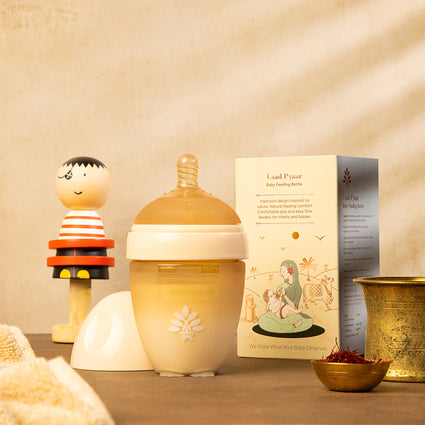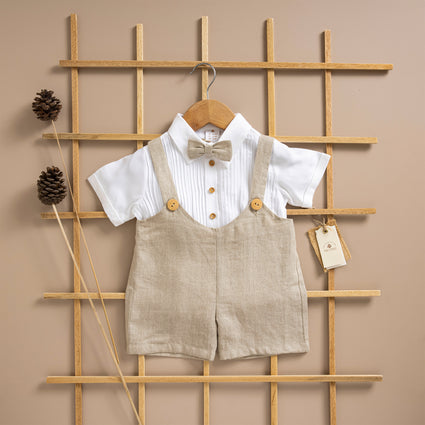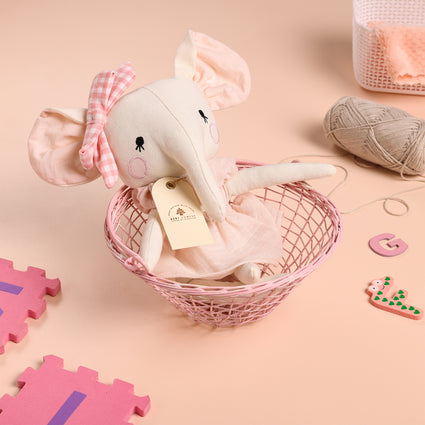Baby Care & Parenting Blogs

Jatakarma: The Baby's First Ritual.
The world is full of diverse cultures and traditions when it comes to the birth of a child. When a baby is born, it is an overwhelming experience for the parents. Amidst taking care of the mother's and baby's medical needs, greeting and attending to family and friends, and ensuring the child's safety, there's also the responsibility of following cultural traditions. These practices hold significant meaning within every cultural system.
These traditions are not just about the baby, but also about the blessings and guidance from elders and deities. From baptism in Catholicism to B'rit Milah in Judaism, from Hatsumiyamairi in the Shinto tradition to the reading of the Guru Granth Sahib in Sikhism, these are all ways of celebrating the arrival of a newborn and receiving blessings. A common practice across many cultures is giving the baby a sweet taste shortly after birth.
The belief behind this pre lacteal feeding is that it will make the baby's speech sweet as well. In Hinduism, this tradition is part of the 'Jatakarma' ceremony. Scientifically, it is thought to help activate the baby's five senses independently after being separated from the mother.
Do you remember your mother or grandma telling you that when you were born, your dad made you taste honey on the very first day of your life?
What is Jatakarma?
Jatakarma is a tradition followed by Hindus. After the mother, the father plays a significant role in introducing the baby to the world. During the ceremony, the father chants the names of gods or mantras into the baby's ears, promoting positive energy and prosperity. The ritual is then completed by touching honey or ghee to the baby's lips, symbolizing the bond between father and child. This ceremony signifies the passing of good traits from the elders to the younger generation. A respected individual performs the ritual to bestow good luck upon the child.
Jatakarma is deeply rooted in our culture and has been passed down through tales and fables. It holds both cultural and scientific importance. It is believed that these rituals support a child's growth and development during their early years.
While some rituals have evolved in today's world, the essence of the Jatakarma ceremony remains the same. It reminds us of the deep cultural roots that connect us to our ancestors and the timeless traditions that continue to guide us in welcoming new generations into our lives.

Everything You Need to Know About the Naamkaran Ceremony
The birth of a baby brings immense joy to a family, and with this joy comes the responsibility of choosing the perfect name. In Indian culture, this significant moment is celebrated through a traditional ceremony known as Naamkaran or the Naming Ceremony. This ancient ritual holds deep cultural and spiritual significance, as it marks the official naming of a newborn and is believed to shape the child's identity for life.
Historical and Cultural Background
Naamkaran is one of the sixteen sacraments, or "Samskaras," in Hindu tradition. It is believed to purify and sanctify various stages of life. While the tradition is deeply rooted in Hindu culture, it is also practiced by other communities across India, including Sikhs, Jains, and Buddhists, each with its unique rituals and customs.
In Hinduism, the naming ceremony is considered sacred and is often mentioned in ancient texts like the Manusmriti and the Garuda Purana. These texts emphasize the importance of choosing a name that has a pleasing sound and carries a positive meaning and auspicious associations.
What Is the Right Time for Naamkaran Sanskar?
Traditionally, Naamkaran is performed after the Sutika period ends, typically on the eleventh or twelfth day after the baby's birth. However, after consulting with a priest, parents can choose to perform the ceremony on any auspicious day within the first 100 days or before the child's first birthday.
The Naamkaran Ceremony: A Step-by-Step Guide
Preparation
Preparing for the Naamkaran ceremony begins with selecting an auspicious date and time, often determined by consulting a priest or astrologer who considers the baby's birth chart (Janam Kundli). This ensures that the name chosen is in harmony with the child's astrological signs, potentially bringing good fortune and happiness.
The family also prepares for the ceremony by cleaning the house, decorating the space with flowers and rangoli (traditional patterns made on the floor), and setting up a sacred altar where the rituals will take place.
Rituals of Naamkaran
Havan Poojan: The parents perform the Havan Poojan for the prosperity and well-being of their baby. In the presence of Agni (the Fire God), the elements, Mother Earth, and the Sun, it is believed that this ritual enhances the child's future by formally recognizing their identity.
Choosing the Name: According to traditional customs, a syllable for the baby's name is often chosen based on their moon sign, the initials of their nakshatra (birth star), or their sun sign. However, it is not mandatory to follow these signs strictly. Nowadays, many parents decide on their baby's name in advance, while others seek guidance from a priest to choose a name that aligns with astrological signs.
Announcing the Name: Once the name is chosen, the father writes it on a bronze plate filled with rice grains, optionally using a gold ring. He whispers the chosen name four times into the baby's right ear before formally announcing it to family and friends.
Post-Ceremony Traditions: After the Naamkaran, the family may host a feast to celebrate the occasion, where guests are served traditional foods and sweets. It is also customary for family members and friends to give gifts to the baby, often in the form of clothes, jewellery, or money, as blessings for a prosperous future.
Choosing the Right Name: Factors to Consider
- Cultural and Religious Significance: Many families choose names with cultural or religious importance, like those of deities or saints, believed to bring blessings.
- Meaning and Symbolism: Names that convey positive qualities or are linked to nature, virtues, or spiritual concepts are often favoured for their meaningful connotations.
- Modern Trends vs. Traditional Names: Parents today often balance traditional names with modern, unique choices, aiming to respect cultural roots while embracing contemporary trends.
- Numerology and Astrology: In many Indian families, names are selected based on numerology or astrology, aligning with the baby's birth chart for luck and harmony.
In today's globalized world, the practice of Naamkaran has evolved to accommodate modern lifestyles and diverse family backgrounds. Interfaith marriages, exposure to different cultures, and the desire for unique names have all influenced how families approach the naming ceremony.
Many parents now opt for names that are easy to pronounce and have universal appeal, especially in urban settings where children are exposed to different languages and cultures. However, the core essence of the Naamkaran ceremony—the joy of welcoming a new life and bestowing a meaningful name—remains unchanged.
A Parent's Guide to Baby Ear Piercing: Here’s What You Ne...
Baby ear piercing is a common practice in many cultures around the world, often steeped in tradition and personal significance. Whether you are considering ear piercing for your baby for cultural, aesthetic, or personal reasons, it's important to understand the process, the benefits, and the necessary aftercare. This guide will provide you with everything you need to know about baby ear piercing, ensuring you make an informed and safe decision for your little one.
Cultural Significance of Baby Ear Piercing
In many cultures, ear piercing for babies is more than just a fashion statement; it holds deep cultural and religious significance. One such tradition is the Karnavedha Sanskar, an ancient Indian ritual where a baby's ears are pierced. The Karnavedha ceremony is one of the 16 sacraments, or 'samskaras,' in Hindu culture, symbolizing the child's ability to hear and absorb knowledge.
Indian baby ear piercing is often performed during a special ear-piercing ceremony where family and friends gather to celebrate. This event is seen as a rite of passage and is usually conducted by a priest or a trained professional. The Karnavedha sanskar is believed to have several spiritual and health benefits, including the stimulation of vital energy points and the improvement of cognitive functions.
When to Pierce Your Baby's Ears
The ideal time to pierce a baby's ears varies among cultures and personal preferences. Some parents choose to do it when their baby is just a few months old, while others may wait until the child is older. There are several factors to consider when deciding the best time for a baby ear piercing:
-
Age
Many pediatricians recommend waiting until the baby has received their first set of vaccinations, usually around 2-4 months old. At this age, the baby's immune system is more developed, reducing the risk of infection. -
Pain Tolerance
Younger babies may tolerate the discomfort of ear piercing better than older children, who might remember the pain and be more resistant to the procedure. -
Healing Process
Babies tend to heal faster than older children and adults, making the recovery period shorter and potentially less complicated.
The Ear-Piercing Procedure
Knowing what to expect during the ear-piercing ceremony can help you prepare and reduce anxiety for both you and your baby. Here's a step-by-step overview of the process:
-
Preparation
Clean the baby's earlobes with an antiseptic solution. The professional will mark the exact spots where the earrings will be placed. -
Piercing
Using a sterilized piercing instrument or needle, the professional will quickly pierce the earlobes. The use of a quick and efficient method helps minimize discomfort. -
Aftercare Instructions
The professional will provide detailed aftercare instructions to ensure proper healing and prevent infection. Follow these instructions carefully for the best results.
Benefits of Baby Ear Piercing
There are several perceived ear-piercing benefits for babies, especially within cultural contexts:
-
Cultural Identity
For many families, piercing a baby's ears is a way to connect with cultural traditions and instill a sense of identity from a young age. -
Health Beliefs
In some traditions, ear piercing is believed to have health benefits, such as improving eyesight and enhancing brain development. The Karnavedha sanskar, for example, is thought to stimulate important energy points in the body. -
Aesthetic Appeal
Many parents choose to pierce their baby's ears for aesthetic reasons, appreciating the look of small earrings on their child.
Aftercare Tips
Proper aftercare is essential to ensure that your baby's ears heal properly and to avoid complications. Here are some key aftercare tips:
Cleaning:
Clean the pierced area twice daily with an antiseptic solution or saline water. Avoid using alcohol or hydrogen peroxide, as these can dry out the skin and delay healing.
Avoid Touching:
Try to minimize touching or twisting the earrings to prevent irritation and introduce bacteria. Always wash your hands before handling the earrings.
Monitor for Infections:
Keep an eye out for signs of infection, such as redness, swelling, discharge, or increased tenderness. If you notice any of these symptoms, contact your pediatrician immediately.
Earring Material:
Use hypoallergenic earrings, preferably made of surgical steel, gold, or platinum, to reduce the risk of allergic reactions.
Baby ear piercing is a significant decision that involves careful consideration of cultural practices, health benefits, and personal preferences. Whether you're participating in a traditional Karnavedha ceremony or simply choosing to pierce your baby's ears for aesthetic reasons, it's essential to understand the process and follow proper aftercare instructions. By selecting a qualified professional and adhering to recommended practices, you can ensure a safe and positive experience for your little one. Celebrate this special milestone with confidence, knowing that you've made an informed and thoughtful choice for your baby's well-being.
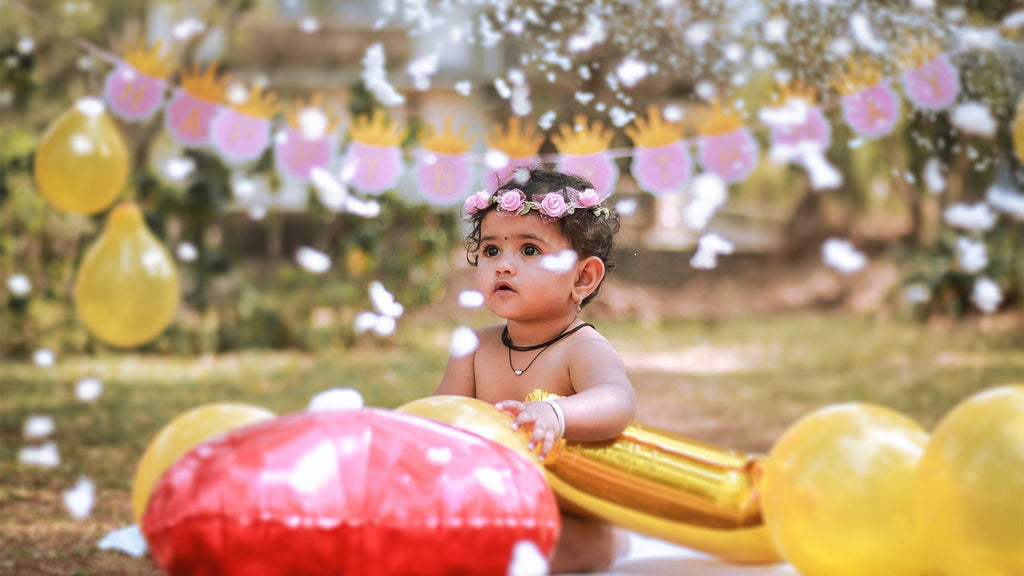
5 Baby Rituals That Every Parent Should Know
Rituals and development are deeply intertwined in the life of a child. Every culture has traditions that are considered vital for a child's growth and well-being. These rituals have been integral to cultural practices for centuries. In today's interconnected world, where the internet has blurred cultural boundaries, it's easier than ever to explore and embrace practices from different traditions. For example, Hindu rituals for newborn babies are known for their profound impact on a child's development and well-being. Here are five significant sanskaras from Hinduism that ensure a baby's healthy and holistic growth.

Jatakarma (Birth Ritual)
Remember your mother or grandma telling you that when you were born, your dad made you taste honey or ghee on the very first day of your life? The tradition is called Jatakarma! This is the first ritual for a newborn baby to celebrate the birth of the baby. After the mother, it is the father through whom a baby knows the world. A father chants the name of gods or mantras in a baby's ears, promoting positive vibes. The ritual is completed by touching honey or ghee to the baby's lips. Hence, this signifies the bond between a father and a baby.

Naamakaran (Name Giving)
Naamkaran is one of the most significant Hindu rituals for a newborn baby. For the naming ceremony, parents perform a Hawan to promote positive and healthy vibes. On the auspicious day of Naamkaran, the child dresses in new baby clothes, and the religious leader prepares a horoscope. This tradition is vital for a child's identity because official announcements about the name are made to friends and family. The decided name is also whispered in the child's ear by the father in a few cultures.

Nishkrmana (The First Outing)
Approximately in the fourth month, parents take their little ones out of the home for the first time(Nishkrmana). Five components of nature, like earth, water, air, fire, and space, are introduced to the child. The moon and the sun are also shown and worshipped for the positive growth of the baby. This also indicates that the sense and motor organs of the baby are now strong enough to tolerate the sun's energy. This tradition also demonstrates to parents that a child is never confined to the boundaries and limits of the house.

Annaprashan (The First Solid Food)
Annaprashan is a cherished Hindu ritual that marks the introduction of solid food to a newborn baby, typically occurring when the baby is around six months old. This tradition marks the establishment of an adult diet for a baby for the rest of their life. It is essential for physical and mental development as the teething process starts now. Children learn about new feeding methods that involve them individually. Popularly, rice grain is fed to the child through kheer annaprashan is followed in different cultures with different names. Hence, the food varies accordingly.

Chaul ( Shaving of The Head)
Chaul, also known as Mundan, is a significant Hindu ritual where a newborn baby's head is shaved for the first time. The act of shaving the head is believed to cleanse the child of past life's negativity, symbolizing a fresh start and the removal of impurities. But scientifically, it helps absorb vitamin D from sunlight and keeps the baby's head cool in the summer. It also stimulates the proper growth of nerves and the brain. This ceremony is also significant for the baby's cradle cap as it gets removed over time, and the new, healthier hair growth gets promoted.
Significance Of Hindu Rituals for Newborn Babies
Hindu rituals hold great importance in the lives of believers, serving as a way to connect with the divine and maintain a sense of spiritual discipline. These rituals, whether they involve daily prayers, festivals, or special ceremonies, help individuals express their devotion and gratitude to the gods and goddesses. They also play a vital role in preserving cultural heritage and passing down traditions, values, and stories from one generation to the next. Through these rituals, Hindus find a deeper meaning in their daily lives, feel a sense of community, and gain peace and purpose.
Scientific Facts Behind Hindu Rituals
Many Hindu rituals for newborns have scientific underpinnings that support a child's development. For instance, shaving a baby's head (Mundan) promotes hair growth and scalp hygiene. Introducing solid foods around six months (Annaprashan) aligns with pediatric guidelines, aiding in nutritional balance and palate development. Ear piercing (Karnavedha) is believed to stimulate acupressure points beneficial for vision and brain health, while also being less painful and healing faster in young children.
Exposing a newborn to morning sunlight provides essential Vitamin D for bone health. Regular oil massages (Abhyanga) improve blood circulation, promote better sleep, and support neurological development. These practices blend cultural wisdom with scientific benefits, ensuring holistic growth for the child.
These practices are devoted from generation to generation. At the same time, the ways of doing them have been modernized over time. The five essential sanskaras impact a child scientifically and boost healthier development. Every parent may follow these customs, whether in the form of sanskaras or just as a habit. These can be followed by anyone, as they require the bare minimum but play a significant role in a baby's upbringing in the initial year.

Early Signs of Postpartum Complications: What to Look Out...
Experiencing the arrival of a new baby is a joyful and life-changing experience for parents. However, the postpartum period, the first six weeks after childbirth, can be a challenging time as the mother's body undergoes significant changes to recover from pregnancy and delivery. While many mothers recover without complications, some may experience postpartum complications that require immediate medical attention.
Recognizing the early signs of potential complications during pregnancy is crucial. By staying informed about these symptoms, expectant mothers can seek prompt medical care, which can greatly influence the pregnancy's outcome. This blog talks about early signs of postpartum complications to help you understand what to watch for and when to seek medical help.
What are Postpartum Complications?
Postpartum complications can occur for various reasons, including infections, cardiovascular issues, and mental health challenges. Preventing major health issues requires early discovery and treatment. Knowing the warning signs can make a significant difference in outcomes for new mothers.
1. Postpartum Hemorrhage (PPH)
One of the most serious postpartum complications is excessive bleeding, known as postpartum hemorrhage (PPH). PPH usually develops within 24 hours of delivery; however, it can sometimes arise up to 12 weeks later. It is distinguished by profuse bleeding that goes through more than one sanitary pad each hour or the passage of big blood clots. Other symptoms include dizziness, fainting, a rapid heart rate, and low blood pressure. If not treated promptly, PPH can lead to severe blood loss and shock .
2. Infections
Infections are another common postpartum complication that can occur in the uterus (endometritis), at the incision site of a cesarean section, or in the perineal area. Symptoms of an infection include a fever of 100.4°F (38°C) or higher, foul-smelling vaginal discharge, and pain or swelling at the incision or perineal area. Untreated infections can cause major health difficulties, so it's crucial to check for these indicators and seek medical attention if necessary.
3. Deep Vein Thrombosis (DVT)
Deep vein thrombosis (DVT) is a disorder in which blood clots form in deep veins, typically in the legs. This can be a risk if the clot spreads to the lungs and causes a pulmonary embolism. Symptoms of DVT include swelling, redness, warmth, and pain in one leg, typically the calf. The affected leg may feel tender, and the pain may worsen when walking. It is important to seek medical attention immediately if these symptoms are observed.
4. Postpartum Preeclampsia
Preeclampsia is a disorder that causes high blood pressure and excess protein in the urine during pregnancy, but it can also occur after birth. Postpartum preeclampsia typically occurs within 48 hours to six weeks after delivery. Warning signs include severe headaches that do not respond to medication, vision changes such as blurriness or light sensitivity, and swelling in the face, hands, or legs. Early diagnosis and treatment are essential to avoid consequences like seizures or stroke.
5. Cardiovascular Issues
Heart-related complications can also arise during the postpartum period. Peripartum cardiomyopathy, a type of heart failure that occurs during the last month of pregnancy or up to five months postpartum, can cause symptoms such as shortness of breath, chest pain, extreme fatigue, and a rapid heartbeat. These symptoms should not be ignored, as they may indicate serious cardiovascular issues that require immediate medical attention.
6. Mental Health Conditions
Mental health issues are common postpartum complications, ranging from the "baby blues" to more severe conditions such as postpartum depression (PPD) and postpartum psychosis. Postpartum depression symptoms include continuous melancholy, hopelessness, significant mood fluctuations, difficulties bonding with the infant, and suicidal ideation. Postpartum psychosis is a rare but significant mental illness that can cause hallucinations, delusions, and severe agitation. If these symptoms appear, seek immediate medical attention, as early intervention can result in better outcomes.
When to Seek Medical Attention
It's important to seek medical attention promptly if any of these symptoms occur. Early identification and treatment can greatly improve the outcomes for new mothers. The American College of Obstetricians and Gynaecologists (ACOG) recommends that postpartum visits be planned within the first three weeks of birth, followed by a full evaluation at 12 weeks. Additional visits may be necessary for those with specific health risks.
Prevention and Management of Postpartum Complications
While not all postpartum complications can be prevented, taking proactive steps can help manage risks. Discussing health history with an OB/GYN during pregnancy, attending all postpartum checkups, and staying in close contact with a healthcare provider if any unusual symptoms arise are essential measures. Developing a postpartum care plan before delivery and having support systems in place can also make a significant difference in managing postpartum health.
Related Read - Nourishing the New Mother: Ayurvedic Postnatal Care Practices
The postpartum period is a critical time for new mothers as they adjust to life with their newborns. Recognizing the early signs of postpartum complications can save lives and ensure a smoother recovery. Staying aware and vigilant allows new moms and their families to take proactive efforts to treat any health issues that develop, safeguarding the health of both mother and baby. Always consult with healthcare providers for personalized advice and care, and do not hesitate to seek help if any concerning symptoms occur.
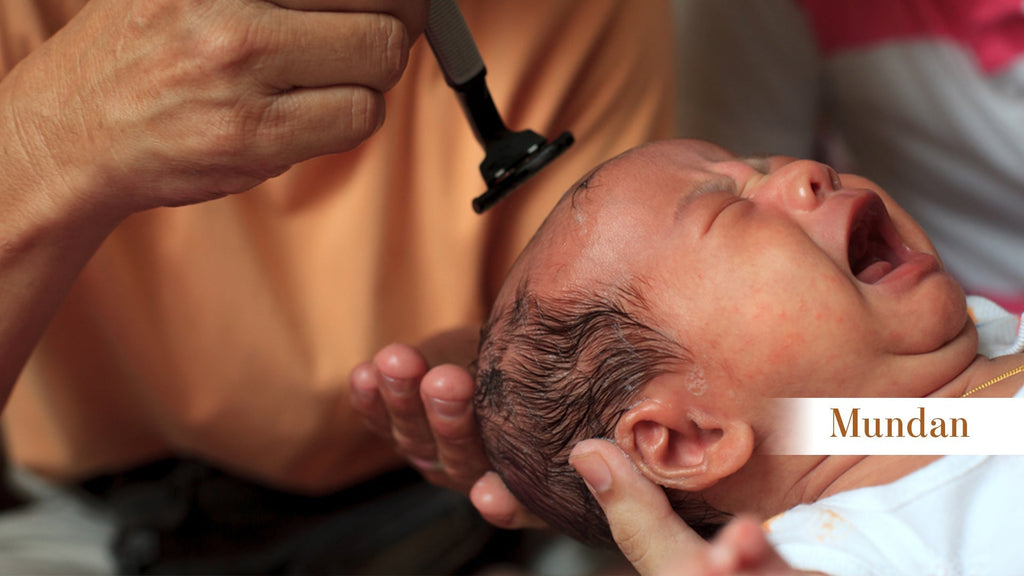
Mundan Ceremony: The Baby's First Haircut
The first things related to babies are always extraordinary and special. And in Hindu culture, the first haircut is primarily ceremonious. Commonly known as Mundan, the ritual is called choodakaran or chaul in some parts of India.
According to Ayurveda, the ritual of mundan is believed to help regulate the body's temperature and maintain cerebral balance, thus promoting better and healthier growth. The act of shaving the head is also thought to open the crown chakra, enhancing the body's energy flow, which is vital for mental and physical health. Additionally, Ayurveda suggests that this practice can remove impurities and past karma, potentially improving the child's well-being.
What is the Mundan Ceremony for Babies?
The Mundan ceremony is a special event/ritual for babies in some cultures, particularly among Hindus. It involves shaving off the baby's first hair, usually when they are around one to three years old. People believe this ceremony cleans the baby from their past life, protects them from evil, and blesses them with a good future. Family members, friends, and a priest usually gather to celebrate this occasion with prayers and blessings. The Mundan is both a religious ritual and a joyful family gathering, marking an important milestone in a baby's life.
When And How Should You Do Mundan?
Ideally, the ceremony should be performed from the first year till the third year of a baby. The time is correct because the child is not as delicate as a newborn. In exceptional cases, parents can do the mundan later as well. But, doing the mundan at an odd number of months and years is suggested. It can be done at 7, 9, or 11 months of age. Some families follow the auspicious time indicated by the priest.
On the day of the ceremony, a havan is performed by the priest. The mother holds the baby in her lap. The priest shaves a small amount of hair first. Then, the barber continues to shave the rest. Following the hair cutting ceremony, sandalwood and turmeric is applied on the baby's head. This protects the baby's head from infections, heals the cuts, if any, and Chandan cools down the temperament.
Where is the Mundan Ceremony Performed?
The Mundan ceremony can be performed in various locations depending on family traditions and preferences. Commonly, it takes place in a religious setting such as a temple, which provides a sacred environment for the ritual. However, some families choose to hold the mundan ceremony for their baby boy or girl at their home for a more intimate setting, especially if they wish to include only close relatives and friends. In some cases, it may also be conducted at a pilgrimage site or a significant religious place, adding spiritual significance to the event.
Is Performing Mundan Important for Your Baby?
Every ceremony in traditions has some deeply rooted significance. Some of them are scientific, and some of them are logical beliefs. Here are the benefits of Mundan:
- It marks the beginning of a new life and removes any negativity from the past life.
- It plays a very important role in healthy hair growth.
- It helps the baby during teething by toning down the pain.
- It marks the learning of cleanliness for a child.
- It supports the development of nerves in the brain
- It provides coolness in summer.
Precautionary Tips for a Safe Baby Mundan Ceremony
- Be gentle to your baby. Let them rest well before the ceremony.
- The person doing the mundan should be well trained for it.
- In the case of the salon, avoid having a mirror in front of a baby. It might not be pleasing for them to see, and they can feel terrified by the image.
- Don't make the ceremony crowded. Even though some people choose to do a grand celebration, it might be too overwhelming for a baby.
- Instruments like razors or scissors should be sterilized and cleaned.
Some parents choose to perform the Mundan Ceremony at the holy places of Ganga Ghats or temples. In contrast, some of them conduct the ceremony at home. These days mundan is also conducted at salons. Wherever it is, Mundan is one of the most important Sanskar out of sixteen Sanskaras in Hinduism. Every strand of hair is kept to be offered to the deities. In some traditions, they are immersed in the holy river Ganga.
Related Read - 5 Baby Rituals That Every Parent Should Know

Annaprashan: The First Meal Of Your Baby
Welcoming a new baby into the world comes with many cherished moments and milestones. One such significant event in many cultures, particularly among Hindus in India, is the Annaprashan ceremony. This traditional ritual celebrates the baby's first introduction to solid food.
What is Annaprashan Ceremony?
Anna means grain, and prashan means feeding. Annaprashan, also known as the rice ceremony, signifies the initiation of feeding grain to a baby. The same ceremony is known as Bhat Khulai in Himachal Pradesh, Choorunu in Kerela, and Mukhe Bhaat in West Bengal. Ancient Religious Hindu Text Smriti describes it as one of the most important sanskaras out of sixteen rites.
Why Is Annaprashan An Important Ceremony?
Food is vital to human existence. We are complete when we eat and the cycle goes on for the rest of our lives. But an introduction to feeding a newborn is a steady process. Annaprashan is scientifically essential as it introduces the baby to the guide to get the required nutrients they cannot get from breastmilk, and they must learn to feed on solid food.
When Should You Perform Annaprashan?
The date for Annaprashan is usually based on the baby's health and the Hindu lunar calendar to ensure it falls on an auspicious day. Culturally, Annaprashan is performed four to six months after birth. It is auspicious to do the Annaprashan ceremony for baby girls on odd months like five or seven, and even ones are auspicious for boys. Before six months, it might be dangerous to feed solid food as their immunity is low, and they might find it difficult to digest.
Types of Food Offered to the Baby During the Ceremony
During the Annaprashan ceremony, the primary type of food offered to the baby is usually a soft, well-cooked rice-based dish. This is often in the form of a sweet rice pudding known as 'kheer' or 'payesh' in various parts of India. The rice is cooked with milk and sugar, making it easy for the baby to digest. In some families, the first food might also include mashed fruits like bananas or cooked vegetables like sweet potato, depending on regional traditions and family preferences.
What are the Rituals Followed in Annaprashan?
The annaprashan ceremony can take place at home or in a temple, depending on the family's preference and the significance they attach to the location. Temples are often chosen for the spiritual ambience and the presence of a priest to conduct the ceremony with traditional rituals.
Every culture has beautiful details about the ceremony, followed by family customs. Some of them are common to all. For instance, feeding rice pudding or kheer is standard, while bathing a child in sandalwood and turmeric is critical to Bengali culture. Children get dressed in traditional ways, followed by being fed by their father, grandfather, or maternal uncle. Everyone at the ceremony feeds some amount of food to the baby and puts rice and grass on the baby's head.
During the Annaprashan ceremony, there's a ritual followed by the rice feeding ceremony where the baby is presented with a variety of objects like a book, pen, clay, money, silver plate, and food placed around them. It is exciting to see which item the baby will reach for first. It's believed that the object the baby chooses can hint at their future interests or careers. For example, if the baby picks up a pen, it might suggest they have a love for writing or learning. If they grab a coin, it could mean they'll be good at managing money.
The presence of friends and family makes the ceremony memorable for child and their friends. But it might be too immense for your Lil one. Keep your guest list short and precise. Even though it's a part of the ceremony, the child might feel moody and cranky since everyone is feeding them. Give them some space and remember to make fun memories.
Related Read - 5 Baby Rituals That Every Parent Should Know.

Baby Playtime Guide: What You Must Consider While Playing...
This blog is different from a typical guide about the process of playing with kids. There's no hard rule to it! Still, there are a few unnoticeable things that can have a significant effect on your child. During or after playtime, their little brains must be filled with thoughts that are hard to know. Their little curious minds should experience playtime as an experience that makes them happy and is cherishable as they remember, for both the parents and children. By taking care of some little things, you can turn that crucial and intrinsic play time into their being more fun and enjoyable.
What You Must Consider?
1. Taking time out constantly:
One of the major drawbacks of our modern living is the shortage of time. We always run less on time and might sometimes feel too tired to play with kids. But, a child communicates and explores the world through their parents. And for this communication, playtime plays an important role. So, try your best to take out some to play regularly. Keeping your efforts constant for babies will help them to relate more and develop healthy bonds from the beginning of their life.
2. Play with them at their level
Getting down at the child's level and letting them decide things is very important for their self-concept. The game rules for an adult shouldn't be a thing when you are playing with a kid or even a toddler! Matching their body language will also make them comfortable. Hence, they will be able to express their creativity freely. So, try to be a kid when playing with a kid.
3. Describing and Praising
Narrating your actions like "now we will put this block here" will give a child insight and help them develop their language skills. Secondly, praising their actions will contribute to their idea of self-growth.
4. Always give closure
Never leave a child in the middle of the game. Always try to complete it, and if it is urgent, try to provide them a closure. No closure might give them anxiety, and this uncertainty might root in their personality. Always provide them with a conclusion! Like, "you have won."
5. A balance of control
The right amount of participation is significant for their growth and development. Not telling a child what to do and telling too much about it is never a good option. When a child is left free, they feel negligent, and extra control lowers their self-esteem.







